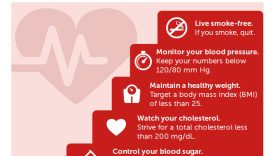Empowering Yourself with Healthy Choices and Habits

In today’s fast-paced world, the importance of making healthy choices and developing positive habits cannot be overstated. We often find ourselves overwhelmed with responsibilities, and self-care can slip down our list of priorities. However, dedicating time to focusing on one’s health can lead to transformative changes that affect not just individuals but their families and communities as well.
- Empowering Yourself with Healthy Choices and Habits
- Why Focus on Health?
- Importance of Healthy Choices and Habits
- Physical Health
- Mental Well-being
- Establishing Healthy Eating Habits
- Meal Planning
- Understanding Nutrition Labels
- Incorporating Regular Exercise into Your Routine
- Cardiovascular Workouts
- Strength Training
- Prioritizing Mental Health and Self-Care
- Mindfulness Practices
- Stress Management Techniques
- Building a Supportive Environment
- Surrounding Yourself with Positive Influences
- Seeking Professional Help When Needed
- Setting Realistic Goals and Tracking Progress
- SMART Goals
- Habit Tracking Methods
- Overcoming Challenges and Staying Motivated
- Dealing with Setbacks
- Finding Inspiration in Your Journey
- The Importance of Consistency and Perseverance
- Creating a Routine
- Staying Committed to Your Health Goals
Why Focus on Health?
A healthy lifestyle contributes to overall happiness and resilience. Consider this:
- Physical Health: Helps prevent chronic diseases and enhances longevity.
- Mental Well-being: Reduces stress and anxiety, boosting one’s mood and outlook on life.
Take Sarah, for example—she struggled with fatigue and mood swings. After adopting healthier eating habits and a consistent exercise routine, she not only felt more energized but also more positive. This change inspired her family to follow suit, creating a ripple effect in their household. As we dive deeper into the practical steps for establishing healthy habits, remember that every small change counts towards a happier, healthier you.
Importance of Healthy Choices and Habits
Building on the foundation of the introduction, understanding the importance of healthy choices and habits is vital for achieving lasting well-being. These choices shape not only how we feel physically but also how we engage with the world around us.
Physical Health
Making healthy choices, such as opting for nutritious foods and engaging in regular exercise, significantly impacts physical health. Benefits include:
- Increased Energy Levels: A balanced diet fuels the body for daily activities.
- Weight Management: Maintaining a healthy weight reduces the risk of chronic diseases.
- Enhanced Immunity: Nutritious foods strengthen the immune system, keeping illnesses at bay.
For instance, John switched from processed snacks to fruits and nuts. Surprisingly, this small change gave him more energy to be active after work, leading to a healthier lifestyle overall.
Mental Well-being
Healthy habits also play a crucial role in mental well-being. Here’s how:
- Reduced Stress: Regular physical activity lowers levels of cortisol, the stress hormone.
- Improved Mood: Nutrient-rich foods support brain function, enhancing mood.
- Boosted Confidence: Achieving fitness goals fosters a sense of accomplishment.
When Lisa started practicing yoga, she found it not only improved her flexibility but also calmed her mind, helping her tackle daily stressors with ease. This harmonious balance between physical and mental health creates a cycle of positivity that enriches every aspect of life.
Establishing Healthy Eating Habits
As individuals embark on their journey to improved health, establishing healthy eating habits is a crucial step. This process not only supports physical and mental well-being but also simplifies daily choices. Two essential strategies in this endeavor are meal planning and understanding nutrition labels.
Meal Planning
Meal planning can be a game changer, reducing stress and promoting healthier choices during busy weeks. Here’s how to get started:
- Set Aside Time Weekly: Dedicate a specific time each week to plan meals and snacks.
- List Your Meals: Choose recipes that are both nutritious and appealing to you.
- Prep Ingredients in Advance: Chop vegetables or cook grains ahead of time to save time during the week.
For Alex, taking just an hour every Sunday to plan meals transformed his hectic evenings into relaxing family time, as dinner was already prepared.
Understanding Nutrition Labels
Reading nutrition labels is another powerful tool for making informed choices. Key components to focus on include:
- Serving Size: Check the portion to avoid overeating.
- Calories: Be mindful of total calorie intake versus your daily needs.
- Nutrients: Look for high fiber, vitamin, and mineral content while minimizing added sugars and unhealthy fats.
When Emma began scrutinizing labels, she discovered many hidden sugars in her favorite snacks. This newfound awareness helped her select healthier alternatives, making her diet more balanced and nutritious. By implementing these strategies, anyone can create a sustainable path to healthier eating.
Incorporating Regular Exercise into Your Routine
Having established healthy eating habits, the next vital component is incorporating regular exercise into daily routines. Exercise not only complements a balanced diet but also reinforces physical and mental health benefits. Key forms of exercise to consider are cardiovascular workouts and strength training.
Cardiovascular Workouts
Cardiovascular workouts are essential for overall heart health and stamina. Engaging in activities that increase your heart rate can be both fun and effective. Here are some engaging options:
- Jogging or Running: Excellent for those who enjoy the outdoors.
- Cycling: A low-impact option that can be done solo or socially.
- Dancing or Aerobics: Fun ways to get moving while enjoying music.
For Sarah, choosing to dance at home transformed her exercise routine. Not only did she improve her cardiovascular fitness, but she also discovered a new passion.
Strength Training
Strength training builds muscle, supports metabolism, and enhances bone density. Integrating resistance exercises can be as simple as:
- Bodyweight Exercises: Push-ups, squats, and lunges require no equipment.
- Weights: Using dumbbells is great for targeting specific muscles.
- Resistance Bands: Portable and versatile, perfect for various exercises.
When Mark began incorporating simple weightlifting twice a week, he noticed increased energy and strength in everyday activities. By blending cardio and strength training, individuals can establish a balanced and enjoyable fitness regimen that supports overall well-being.
Prioritizing Mental Health and Self-Care
After establishing a well-rounded exercise regimen, it’s crucial to prioritize mental health and self-care. Mental well-being is just as important as physical fitness and directly impacts our overall quality of life. Two effective components in this area are mindfulness practices and stress management techniques.
Mindfulness Practices
Mindfulness practices help cultivate awareness of the present moment, reducing anxiety and enhancing emotional stability. Here are a few simple methods you can try:
- Meditation: Dedicate a few minutes daily to sit quietly and focus on your breath.
- Journaling: Writing thoughts or feelings can provide clarity and relieve stress.
- Gratitude Lists: Regularly noting things you’re thankful for can shift your mindset positively.
When Jessica started a nightly meditation routine, she noticed significant changes in her sleep patterns and stress levels, allowing her to face each day with renewed energy.
Stress Management Techniques
Implementing effective stress management techniques can greatly improve mental health. Consider these strategies:
- Time Management: Prioritize tasks to reduce overwhelm.
- Breathing Exercises: Simple techniques can help calm the mind during stressful moments.
- Engaging in Hobbies: Make time for activities that you enjoy and that help you relax.
For Michael, setting aside time for painting became a therapeutic outlet. By actively engaging in self-care through both mindfulness and stress management, individuals can build resilience and nurture their mental health, enhancing their overall quality of life.
Building a Supportive Environment
Having prioritized mental health and self-care, the next step is to build a supportive environment that encourages personal growth and well-being. Surrounding oneself with positive influences and seeking professional help when necessary are integral parts of this process.
Surrounding Yourself with Positive Influences
The company one keeps can greatly impact motivation and emotional health. It’s important to cultivate relationships that uplift and inspire. Consider these tips:
- Identify Supportive Individuals: Surround yourself with friends and family who encourage your goals.
- Join Positive Communities: Seek out groups or clubs that share your interests and values.
- Limit Negative Exposure: Reduce time spent with pessimistic individuals who drain your energy.
When Lisa made a conscious effort to engage with friends who supported her fitness journey, she found herself more motivated and happier in her pursuits.
Seeking Professional Help When Needed
Sometimes, extra support is essential, and there’s no shame in seeking professional assistance. Here’s when to consider professional help:
- Overwhelming Stress or Anxiety: If it becomes difficult to manage on your own.
- Significant Life Changes: During challenging transitions, such as relocation or loss.
- Persistent Feelings of Sadness: Professional guidance can help navigate these emotions.
Mark’s experience with therapy truly transformed his outlook on life, offering strategies to manage stress and build resilience. By prioritizing both positive relationships and professional support, individuals can create a nurturing environment that fosters sustained well-being.
Setting Realistic Goals and Tracking Progress
With a supportive environment in place, the next critical focus is setting realistic goals and monitoring progress. Establishing clear objectives not only maintains motivation but also fosters a sense of achievement. Utilizing SMART goals and habit tracking methods are effective ways to accomplish this.
SMART Goals
SMART goals stand for Specific, Measurable, Achievable, Relevant, and Time-bound. Crafting goals this way can significantly enhance clarity and direction. Here’s how to create a SMART goal:
- Specific: Define what exactly you want to achieve (e.g., “I want to run 5K”).
- Measurable: Determine how you will measure progress (e.g., “Track my running distance each week”).
- Achievable: Ensure the goal is realistic (e.g., “Start with jogging for 15 minutes”).
- Relevant: Align the goal with your broader objectives (e.g., “Improve my overall fitness”).
- Time-bound: Set a deadline (e.g., “Complete the 5K in three months”).
When Anna set a SMART goal to exercise three times a week for a month, she felt empowered and tracked her progress diligently.
Habit Tracking Methods
Habit tracking can keep motivation high and provide insights into personal patterns. Here are some effective methods:
- Journals: Write down daily accomplishments and reflect on what worked.
- Apps: Utilize smartphone applications specifically designed for habit tracking.
- Visual Charts: Create a simple checklist or a calendar to mark completed tasks.
Mark found success using a habit-tracking app that reminded him to drink more water and exercise, turning these steps into enjoyable daily routines. By establishing SMART goals and implementing habit tracking, individuals can effectively navigate their journey towards a healthy lifestyle with confidence and clarity.
Overcoming Challenges and Staying Motivated
Even with well-defined goals and a supportive environment, challenges and setbacks are inevitable in any journey toward self-improvement. The key is how to navigate these hurdles while maintaining motivation. Understanding how to deal with setbacks and finding inspiration in your journey can make all the difference.
Dealing with Setbacks
Setbacks can feel discouraging, but viewing them as learning opportunities can shift your mindset. Here are practical tips for managing setbacks:
- Acknowledge Your Feelings: It’s natural to feel disappointment. Allow yourself to process these emotions.
- Reevaluate Your Goals: Take a moment to review your objectives and adjust them if needed.
- Practice Self-Compassion: Treat yourself with kindness rather than harsh criticism.
When Alex faced an injury that halted his running routine, he took it as an opportunity to explore other activities like swimming, which he ended up loving.
Finding Inspiration in Your Journey
Inspiration can come from various sources and fuel your determination. Consider the following:
- Celebrate Small Wins: Recognize and appreciate every achievement, no matter how small.
- Connect with Like-Minded Individuals: Engage in supportive communities that share similar goals.
- Document Your Progress: Keeping a journal can reveal how far you’ve come, providing motivation for the future.
Jessica found her spark by participating in local fitness events and connecting with others on similar journeys. By embracing challenges and seeking inspiration, individuals can stay motivated and continue progressing toward their health aspirations.
The Importance of Consistency and Perseverance
As individuals navigate their health journeys, the importance of consistency and perseverance cannot be overstated. These qualities serve as the backbone of progress and transformation. Establishing a routine and staying committed to health goals are essential steps in ensuring long-term success.
Creating a Routine
Developing a structured routine helps to integrate healthy habits seamlessly into daily life. Here are some tips to create an effective routine:
- Schedule Regular Workouts: Set specific days and times for exercise, treating them as unmissable appointments.
- Meal Prep on Weekends: Plan healthy meals to prevent last-minute unhealthy choices during busy weekdays.
- Allocate Time for Self-Care: Make self-care activities a non-negotiable part of your routine.
For instance, when Maria instituted a morning workout routine, she felt more energized throughout the day and found it easier to stick to her goals.
Staying Committed to Your Health Goals
Commitment is crucial, especially on challenging days. Here’s how to maintain your focus:
- Set Reminders: Use your phone or sticky notes to remind yourself of your goals.
- Find an Accountability Partner: Sharing your goals with a friend can boost motivation and commitment.
- Reflect on Your ‘Why’: Regularly remind yourself of the reasons behind your health goals.
When Sam felt tempted to skip workouts, reflecting on his long-term health vision helped him stay focused. By prioritizing consistency and perseverance, individuals can build sustainable habits that lead to a healthier, happier life.





